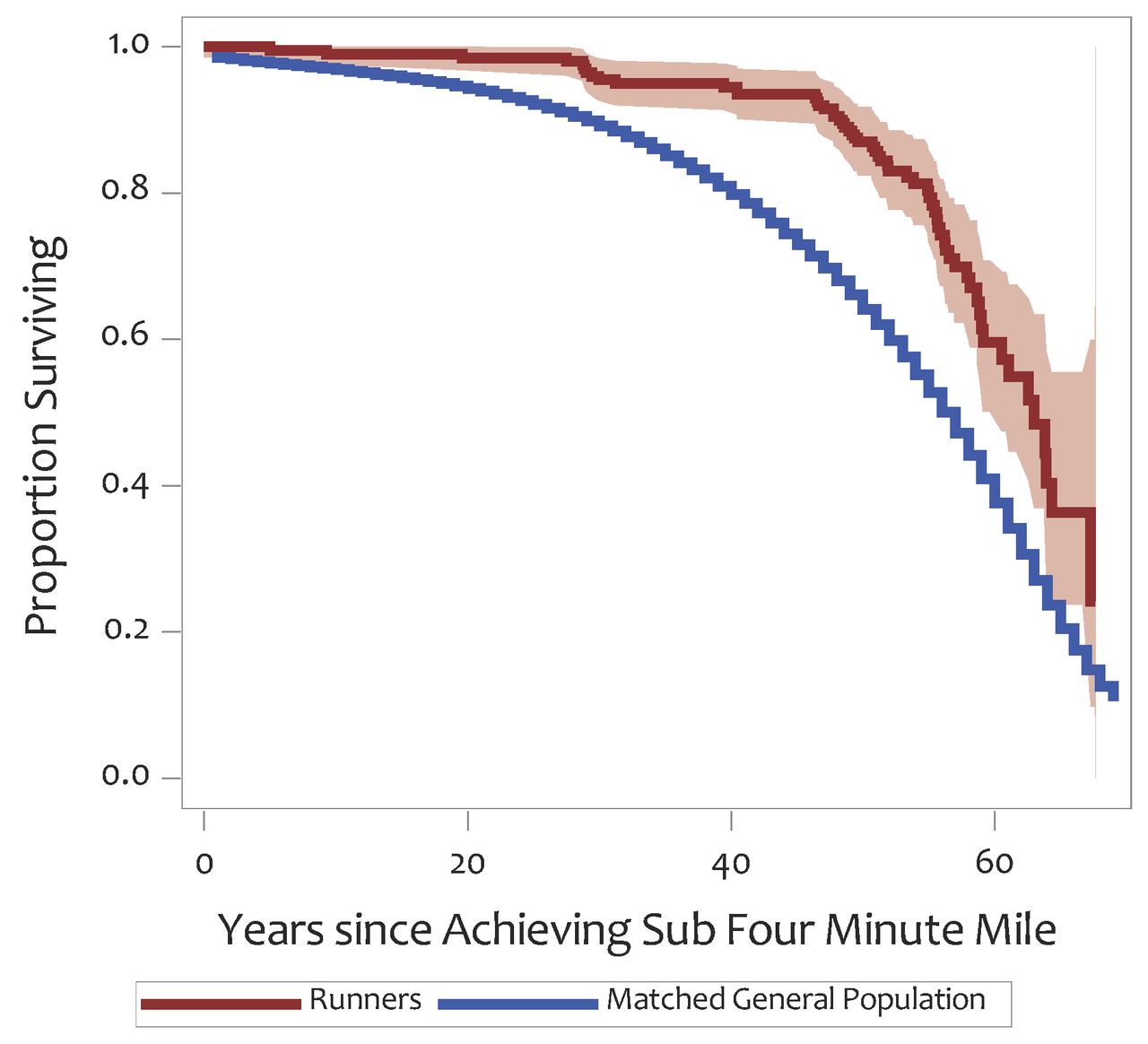Is Running a 4-Minute Mile the Secret to Longevity?

Hard training and good genetics give elite runners an edge, but the 4-minute barrier may have its own magic
By Alex Hutchinson, Outside
The 200th person to break 4 minutes for the Mile, according to the National Union of Track Statisticians, was a Swiss runner named Rolf Gysin. On August 16, 1974, Gysin clocked a 3:56.88. It wasn’t a big surprise: he had already run 3:37 for 1500 meters the year before, which is equivalent to about a 3:54 Mile, and had competed in the Munich Olympics a few years earlier. He was 22 when he broke four; he’s now 72—and still kicking, so to speak.
Gysin was the last guy to make the cut in a new British Journal of Sports Medicine study assessing the longevity of the first 200 runners to break 4 minutes in the Mile, timed to coincide with the 70th anniversary of Roger Bannister’s famous run. Sub-4 doesn’t have the cachet it used to—Track & Field News announced last year that they would stop tracking American sub-4s because the barrier was no longer relevant, though it later reversed the decision—but it’s still a big deal now and was even more so a few generations ago. So did the rigors of pushing their bodies past a once impassable barrier shave years off the lives of these supermen? In a word, no. The study adds another data point to the general finding that elite endurance athletes—Olympians, Tour de France riders, runners—are rewarded with increased longevity. What this finding actually means, though, is perhaps less obvious than it seems.
The study was led by Stephen Foulkes and Mark Haykowsky of the University of Alberta along with André La Gerche of St. Vincent’s Hospital Melbourne in Australia. Its set-up is straightforward. Take the first 200 sub-4 Milers, and hit up Google to see when they were born and when or if they died. Overall, 60 of the 200 men had died, at an average age of 73.6. Those still alive had an average age of 77.6 and counting. The researchers weren’t able to obtain causes of death for everyone, but of the seven who died before the age of 55, six were traumatic deaths or suicide and one was cancer.
Comparing Runners’ Longevity to the General Population
For each runner, they then calculated their life expectancy on the day they broke 4 minutes. For Bannister, the relevant comparison was how long a 25-year-old Englishman would be expected to live in 1954; for Gysin, it was a 22-year-old Swiss in 1974. Then they aggregated the results to see whether the runners had greater longevity than their age- and sex-matched countrymen.
Here’s what the survival curve looks like, with the x-axis showing years since first sub-4 Mile:

SOURCE: British Journal of Sports Medicine
On average the sub-4 runners outlive the matched general population by 4.7 years. There’s a generational effect: those who broke 4 in the 1950s outlived their peers by 9.2 years, while those who did it in the 1960s or 1970s had an edge of 5.5 or 2.9 years, respectively. That could be because the health of the general population is improving thanks to better medical care. But a bigger factor, I assume, is that most of the Milers are still alive. Check back in another decade or two, and Rolf Gysin and his 1970s peers will (touch wood) have added to their longevity stats.
The main spur for this study was the long-running debate on whether “extreme” levels of exercise can damage your health—and lead to heart problems in particular. You may think that running a Mile isn’t very extreme. But training to run a sub-4 minute Mile is definitely extreme: this analysis from a few years ago found that top Milers generally run between 75 and 105 miles a week, with around 20 percent of it at very high intensities. So it’s good news to find that barrier-breaking Milers aren’t dropping like flies.
Still, there are a bunch of caveats to this kind of study. One is that outliving the average person is a pretty low bar to clear. How do athletes fare compared to someone doing the modest amount of exercise recommended by public health guidelines? One estimate found that the equivalent of just five hours of brisk walking per week extends your life expectancy by 4.2 years. Other estimates, to be fair, are less optimistic—but a comparison of sub-4 Milers with, say, 5:00 or 6:00 Milers rather than the average couch-potato would be interesting.
Continue reading at: outsideonline.com
